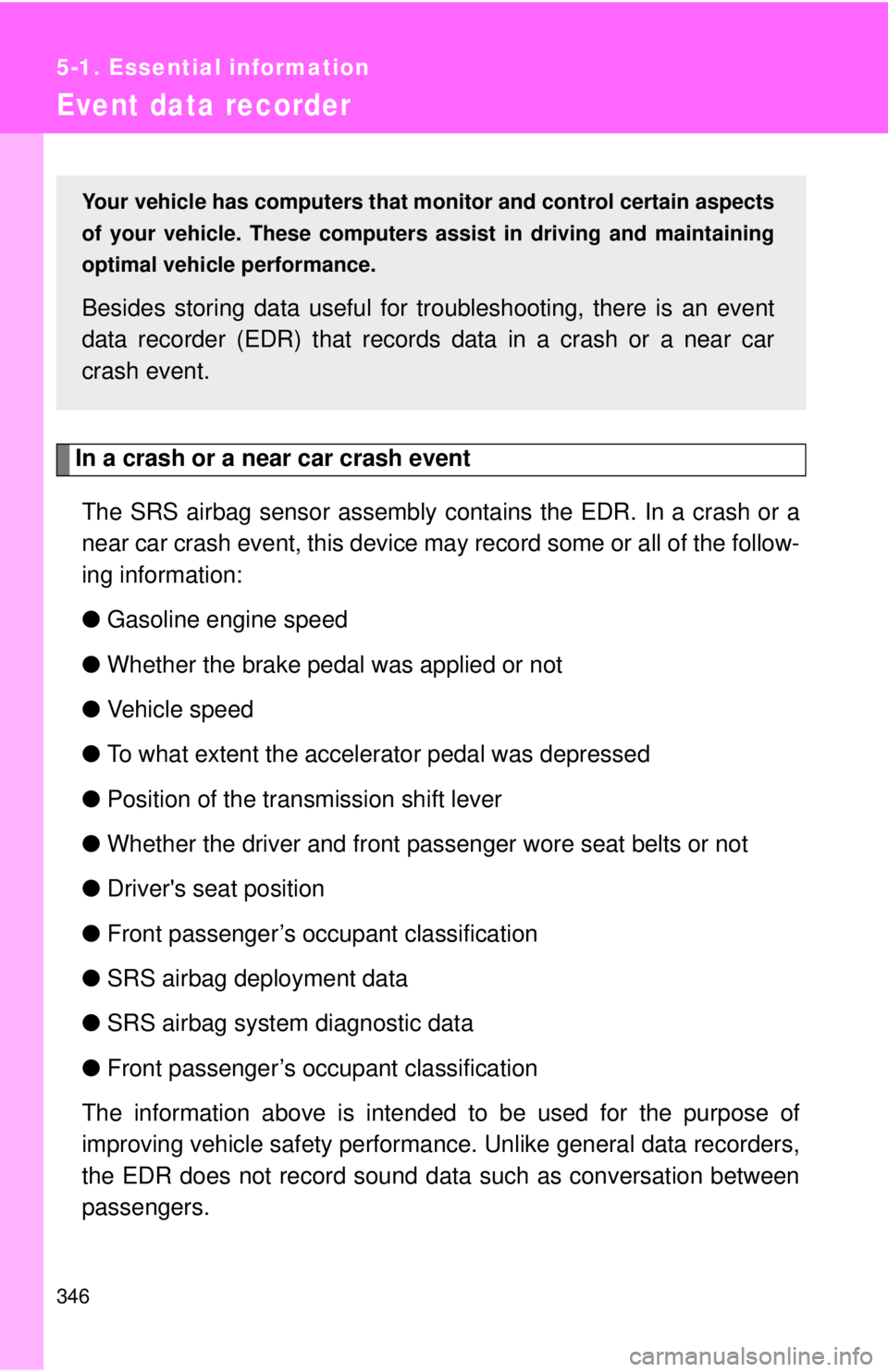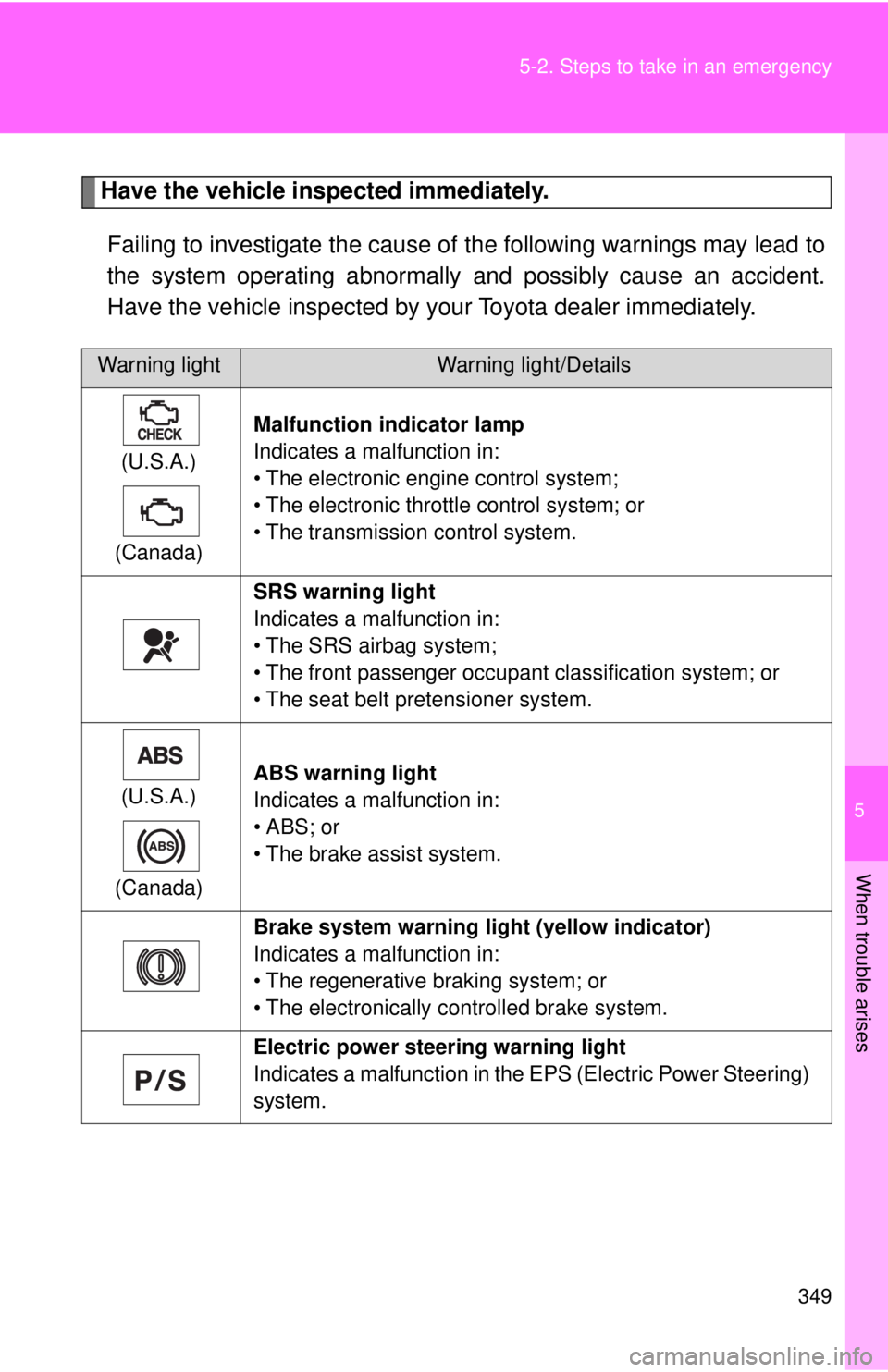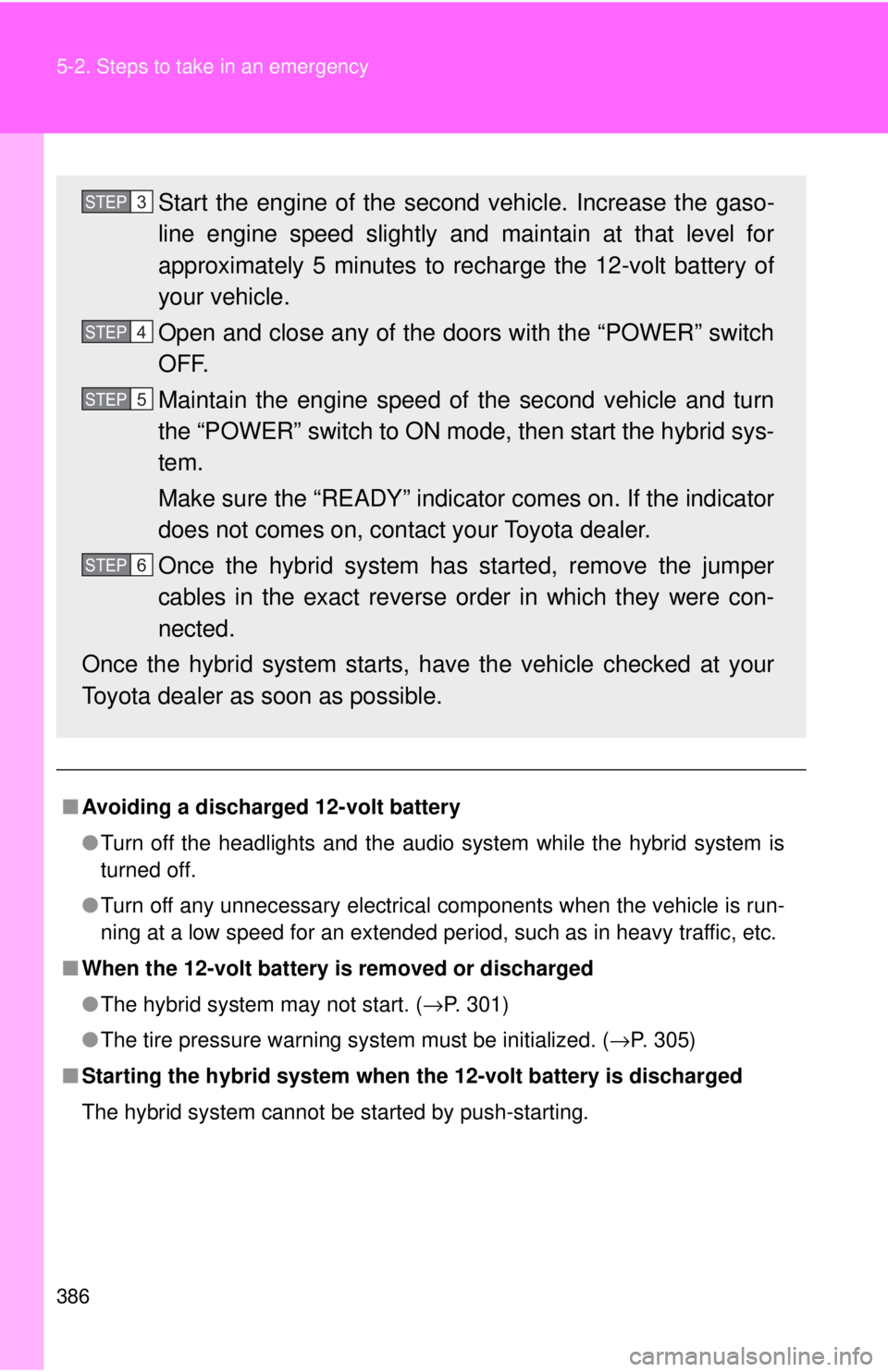Page 328 of 444
328 4-3. Do-it-yourself maintenance
Fuse layout and amperage ratings■ Engine compartment
Fuse box cover
Fuse block
FuseAmpereCircuit
1 SPARE 30 A Spare fuse
2 SPARE 15 A Spare fuse
3 SPARE 10 A Spare fuse
Page 345 of 444
5
When trouble arises
345
5-1. Essential information
If you think something is wrong
If you notice any of the following symptoms, your vehicle probably
needs adjustment or repair. Contact your Toyota dealer as soon as
possible.
■ Visible symptoms
●Fluid leaks under the vehicle
(Water dripping from the air cond itioning after use is normal.)
● Flat-looking tires or uneven tire wear
● Engine coolant temperature ga uge needle continually points
higher than normal
■ Audible symptoms
●Changes in exhaust sound
● Excessive tire squeal when cornering
● Strange noises related to the suspension system
● Pinging or other noises related to the hybrid system
■ Operational symptoms
●Engine missing, stumbling or running rough
● Appreciable loss of power
● Vehicle pulls heavily to one side when braking
● Vehicle pulls heavily to one side when driving on a level road
● Loss of brake effectiveness, s pongy feeling, pedal almost
touches the floor
Page 346 of 444

346
5-1. Essential information
Event data recorder
In a crash or a near car crash eventThe SRS airbag sensor assembly c ontains the EDR. In a crash or a
near car crash event, this device may record some or all of the follow-
ing information:
● Gasoline engine speed
● Whether the brake pedal was applied or not
● Vehicle speed
● To what extent the accelerator pedal was depressed
● Position of the transmission shift lever
● Whether the driver and front passenger wore seat belts or not
● Driver's seat position
● Front passenger’s occupant classification
● SRS airbag deployment data
● SRS airbag system diagnostic data
● Front passenger’s occupant classification
The information above is intended to be used for the purpose of
improving vehicle safety performance. Unlike general data recorders,
the EDR does not record sound data such as conversation between
passengers.
Your vehicle has computers that monitor and control certain aspects
of your vehicle. These computers assi st in driving and maintaining
optimal vehicle performance.
Besides storing data useful for tr oubleshooting, there is an event
data recorder (EDR) that records data in a crash or a near car
crash event.
Page 349 of 444

5
When trouble arises
349
5-2. Steps to take in an emergency
Have the vehicle inspected immediately.
Failing to investigate the cause of the following warnings may lead to
the system operating abnormally and possibly cause an accident.
Have the vehicle inspected by your Toyota dealer immediately.
Warning lightWarning light/Details
(U.S.A.)
(Canada) Malfunction indicator lamp
Indicates a malfunction in:
• The electronic engine control system;
• The electronic throttle control system; or
• The transmission control system.
SRS warning light
Indicates a malfunction in:
• The SRS airbag system;
• The front passenger occupant classification system; or
• The seat belt pretensioner system.
(U.S.A.)
(Canada) ABS warning light
Indicates a malfunction in:
•ABS; or
• The brake assist system.
Brake system warning light (yellow indicator)
Indicates a malfunction in:
• The regenerative braking system; or
• The electronically controlled brake system.
Electric power steering warning light
Indicates a malfunction in the EPS (Electric Power Steering)
system.
Page 358 of 444
358 5-2. Steps to take in an emergency
Stop the vehicle immediately.● The following warning indicates the possibility of damage to the
vehicle that may lead to an acci dent. Immediately stop the vehicle
in a safe place and cont act your Toyota dealer.
● The following warning indicates the possibility of damage to the
vehicle that may lead to an acci dent. Immediately stop the vehicle
in a safe place and allow the engine to cool.
Warning messageDetails
Indicates an abnormal engine oil pressure.
A buzzer also sounds.
The warning light may turn on if the engine oil
pressure is too low.
Indicates a malfunction in the hybrid system.
A buzzer also sounds.
Warning messageDetails
Indicates that the engine coolant temperature is
too high.
A buzzer also sounds.
Page 361 of 444
5
When trouble arises
361
5-2. Steps to take in an emergency
Indicates that the
parking brake is still
engaged with the
vehicle having
reached a speed of
more than 3 mph (5
km/h).
A buzzer also sounds. Release the parking
brake.
Indicates that the
washer fluid level is
low.
A buzzer also sounds. Add washer fluid.
(U.S.A. only) Indicates that the
engine oil is sched-
uled to be changed.
A buzzer also sounds.
Check the engine oil,
and change if neces-
sary.
Comes on approxi-
mately 4500 miles
(7200 km) after the
engine oil is changed.
(The indicator will not
work properly unless
the oil maintenance
data has been reset).
(U.S.A. only) Indicates that the
engine oil should be
changed.
A buzzer also sounds.
Check and change the
engine oil.
Comes on approxi-
mately 5000 miles
(8000 km) after the
engine oil is changed
(and the oil mainte-
nance data has been
reset).
Warning messageDetailsCorrection procedure
Page 363 of 444
5
When trouble arises
363
5-2. Steps to take in an emergency
Messages displayed when refueling
The following messages are displa yed after the fuel lid opener is
pressed. If the messages do not change or are displayed continu-
ously, have the vehicle check ed by your Toyota dealer.
■Changing the engine oil (U.S.A. only)
Make sure to reset the oil change system. ( →P. 295)
MessageDetails
Preparing the vehicle for refueling. Wait a moment.
You may commence refueling. Finish refueling within 30 minutes.
Close the fuel lid.
Page 386 of 444

386 5-2. Steps to take in an emergency
■Avoiding a discharged 12-volt battery
●Turn off the headlights and the audio system while the hybrid system is
turned off.
● Turn off any unnecessary electrical components when the vehicle is run-
ning at a low speed for an extended period, such as in heavy traffic, etc.
■ When the 12-volt battery is removed or discharged
●The hybrid system may not start. ( →P. 301)
● The tire pressure warning system must be initialized. ( →P. 305)
■ Starting the hybrid system when the 12-volt battery is discharged
The hybrid system cannot be started by push-starting.
Start the engine of the second vehicle. Increase the gaso-
line engine speed slightly and maintain at that level for
approximately 5 minutes to recharge the 12-volt battery of
your vehicle.
Open and close any of the doors with the “POWER” switch
OFF.
Maintain the engine speed of the second vehicle and turn
the “POWER” switch to ON mode, then start the hybrid sys-
tem.
Make sure the “READY” indicator comes on. If the indicator
does not comes on, contact your Toyota dealer.
Once the hybrid system has started, remove the jumper
cables in the exact reverse order in which they were con-
nected.
Once the hybrid system starts, ha ve the vehicle checked at your
Toyota dealer as soon as possible.STEP3
STEP4
STEP5
STEP6